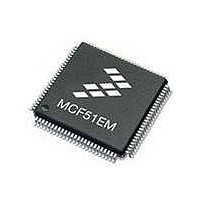MCF51EM256CLL Freescale Semiconductor, MCF51EM256CLL Datasheet - Page 238

MCF51EM256CLL
Manufacturer Part Number
MCF51EM256CLL
Description
IC MCU 32BIT 256KB FLASH 100LQFP
Manufacturer
Freescale Semiconductor
Series
MCF51EMr
Datasheets
1.MCF51EM128CLL.pdf
(2 pages)
2.MCF51EM128CLL.pdf
(54 pages)
3.MCF51EM128CLL.pdf
(636 pages)
Specifications of MCF51EM256CLL
Core Processor
Coldfire V1
Core Size
32-Bit
Speed
50MHz
Connectivity
I²C, SCI, SPI
Peripherals
LCD, LVD, PWM, WDT
Number Of I /o
63
Program Memory Size
256KB (256K x 8)
Program Memory Type
FLASH
Ram Size
16K x 8
Voltage - Supply (vcc/vdd)
1.8 V ~ 3.6 V
Data Converters
A/D 16x12b
Oscillator Type
External
Operating Temperature
-40°C ~ 85°C
Package / Case
100-LQFP
Processor Series
MCF51EM
Core
ColdFire V1
Data Bus Width
32 bit
Data Ram Size
16 KB
Interface Type
RS-232, LIN
Maximum Clock Frequency
50 MHz
Number Of Timers
3
Operating Supply Voltage
1.8 V to 3.6 V
Maximum Operating Temperature
+ 85 C
Mounting Style
SMD/SMT
3rd Party Development Tools
JLINK-CF-BDM26, EWCF
Development Tools By Supplier
DEMOEM
Minimum Operating Temperature
- 40 C
Lead Free Status / RoHS Status
Lead free / RoHS Compliant
Eeprom Size
-
Lead Free Status / Rohs Status
Lead free / RoHS Compliant
Available stocks
Company
Part Number
Manufacturer
Quantity
Price
Company:
Part Number:
MCF51EM256CLL
Manufacturer:
FREESCALE
Quantity:
110
Company:
Part Number:
MCF51EM256CLL
Manufacturer:
Freescale Semiconductor
Quantity:
10 000
- Current page: 238 of 636
- Download datasheet (11Mb)
Interrupt Controller (CF1_INTC)
10.1.1
Interrupt exception processing includes interrupt recognition, aborting the current instruction execution
stream, storing an 8-byte exception stack frame in the memory, calculation of the appropriate vector, and
passing control to the specified interrupt service routine.
Unless specifically noted otherwise, all ColdFire processors sample for interrupts once during each
instruction’s execution during the first cycle of execution in the OEP. Additionally, all ColdFire processors
use an instruction restart exception model.
The ColdFire processor architecture defines a 3-bit interrupt priority mask field in the processor’s status
register (SR[I]). This field, and the associated hardware, support seven levels of interrupt requests with the
processor providing automatic nesting capabilities. The levels are defined in descending numeric order
with 7 > 6 ... > 1. Level 7 interrupts are treated as non-maskable, edge-sensitive requests while levels 6–1
are maskable, level-sensitive requests. The SR[I] field defines the processor’s current interrupt level. The
processor continuously compares the encoded IRQ level from CF1_INTC against SR[I]. Recall that
interrupt requests are inhibited for all levels less than or equal to the current level, except the edge-sensitive
level 7 request that cannot be masked.
Exception processing for ColdFire processors is streamlined for performance and includes all actions from
detecting the fault condition to the initiation of fetch for the first handler instruction. Exception processing
is comprised of four major steps.
10-2
1. The processor makes an internal copy of the status register (SR) and enters supervisor mode by
2. The processor determines the exception vector number. For all faults except interrupts, the
3. The processor saves the current context by creating an exception stack frame on the system stack.
Exit Instruction from ISR
setting SR[S] and disabling trace mode by clearing SR[T]. The occurrence of an interrupt
exception also forces the master mode (M) bit to clear and the interrupt priority mask (I) to set to
the level of the current interrupt request.
processor performs this calculation based on the exception type. For interrupts, the processor
performs an IACK bus cycle to obtain the vector number from the interrupt controller if
CPUCR[IAE] equals 1. The IACK cycle is mapped to special locations within the interrupt
controller’s IPS address space with the interrupt level encoded in the address. If
CPUCR[IAE] equals 0, the processor uses the vector number supplied by the interrupt controller
at the time the request was signaled (for improved performance).
As a result, exception stack frame is created at a 0-modulo-4 address on top of the system stack
defined by the supervisor stack pointer (SSP). The processor uses an 8-byte stack frame for all
exceptions. It contains the vector number of the exception, the contents of the status register at the
time of the exception, and the program counter (PC) at the time of the exception. The exception
Software IACK
Attribute
Overview
MCF51EM256 Series ColdFire Integrated Microcontroller Reference Manual, Rev. 8
Table 10-1. Exception Processing Comparison (continued)
No
RTI
HCS08
Yes
RTE
V1 ColdFire
Freescale Semiconductor
Related parts for MCF51EM256CLL
Image
Part Number
Description
Manufacturer
Datasheet
Request
R

Part Number:
Description:
BOARD DEMO HARDWARE ONLY
Manufacturer:
Freescale Semiconductor
Datasheet:

Part Number:
Description:
IC MCU 32BIT 128KB FLASH 100LQFP
Manufacturer:
Freescale Semiconductor
Datasheet:

Part Number:
Description:
IC MCU 32BIT 128KB FLASH 80LQFP
Manufacturer:
Freescale Semiconductor
Datasheet:

Part Number:
Description:
IC MCU 32BIT 256KB FLASH 80LQFP
Manufacturer:
Freescale Semiconductor
Datasheet:
Part Number:
Description:
Manufacturer:
Freescale Semiconductor, Inc
Datasheet:
Part Number:
Description:
Manufacturer:
Freescale Semiconductor, Inc
Datasheet:
Part Number:
Description:
Manufacturer:
Freescale Semiconductor, Inc
Datasheet:
Part Number:
Description:
Manufacturer:
Freescale Semiconductor, Inc
Datasheet:
Part Number:
Description:
Manufacturer:
Freescale Semiconductor, Inc
Datasheet:
Part Number:
Description:
Manufacturer:
Freescale Semiconductor, Inc
Datasheet:
Part Number:
Description:
Manufacturer:
Freescale Semiconductor, Inc
Datasheet:
Part Number:
Description:
Manufacturer:
Freescale Semiconductor, Inc
Datasheet:
Part Number:
Description:
Manufacturer:
Freescale Semiconductor, Inc
Datasheet:
Part Number:
Description:
Manufacturer:
Freescale Semiconductor, Inc
Datasheet:











